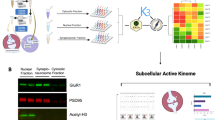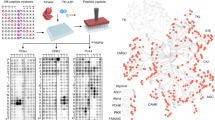Abstract
MITOGEN activated protein (MAP) kinases (MAPKs) are a family of protein-serine/threonine kinases activated as an early intracellular response to a variety of hormones and growth factors1–4. They are unique in requiring both serine/threonine and tyrosine phosphorylation to become active5 and are the only examples of protein-serine/threonine kinases activated by tyrosine phosphorylation. Nerve growth factor (NGF) promotes differentiation of phaeochromocytoma (PC12) cells, which respond by conversion within hours from a chromaffin-like to a sympathetic neuron-like phenotype6,7. NGF stimulation of PC 12 cells increases the activity of two protein kinases by > 20-fold within minutes8, both strikingly similar to MAPKs. They are inactivated by either protein-tyrosine phosphatases or the protein-serine/threonine phosphatase termed protein phosphatase 2A (ref. 8), they activate protein S6 kinase-II (refs 9,10), and they phosphorylate identical threonine residues on myelin basic protein (our unpublished results) to those phosphorylated by other MAPKs11,12. Immunological data13 indicate that these protein kinases, termed peak-I and peak-II (Fig. la) are probably ERK2 and ERK1, respectively, two widely expressed MAPK isoforms13. Here we identify the 'MAP kinase kinases' (MAPKKs) in PC12 cells which are activated by NGF and report that MAPKKs are dependent on serine/threonine phosphorylation for activity and promote phosphorylation of serine/threonine and tyrosine residues on MAPKs.
This is a preview of subscription content, access via your institution
Access options
Subscribe to this journal
Receive 51 print issues and online access
$199.00 per year
only $3.90 per issue
Buy this article
- Purchase on SpringerLink
- Instant access to full article PDF
Prices may be subject to local taxes which are calculated during checkout
Similar content being viewed by others
References
Ray, L. B. & Sturgill, T. W. J. biol. Chem. 263, 12721–12727 (1988).
Rossomando, A. J., Payne, D. M., Weber, M. J. & Sturgill, T. W. Proc. natn. Acad. Sci. U.S.A. 86, 6940–6943 (1989).
Gotoh, Y. et al. Nature 349, 251–254 (1991).
Sturgill, T. W. & Wu, J. Biochim. biophys. Acta 1092, 350–357 (1991).
Anderson, N. G., Maller, J. L., Tonks, N. K. & Sturgill, T. W. Nature 343, 651–653 (1990).
Greene, L. A. & Tischer, A. S. Proc. natn. Acad. Sci. U.S.A. 73, 2424–2428 (1976).
Dichter, M. A. A., Tischer, A. S. & Greene, L. A. Nature 268, 501–504 (1977).
Gomez, N., Tonks, N. K., Morrison, C. Harmar, T. & Cohen, P. FEBS Lett. 271, 119–122 (1990).
Sturgill, T. W., Ray, L. B., Erikson, E. & Maller, J. L. Nature 334, 715–718 (1988).
Lavoinne, A. et al. Eur. J. Biochem. 199, 723–728 (1991).
Erickson, A. K. et al. J. biol. Chem. 265, 19728–19735 (1990).
Sanghera, J. S. Aebersold, R., Morrison, H. D., Bures, E. J. & Pelech, S. L. FEBS Lett. 273, 223–226 (1990).
Boulton, T. G. et al. Cell 65, 663–675 (1991).
Cohen, P., Holmes, C. F. B. & Tsukitani, Y. Trends biochem. Sci. 15, 98–102 (1990).
Tonks, N. K., Charbonneau, H., Diltz, C. D., Fischer, E. H. & Walsh, K. A. Biochemistry 27, 8695–8701 (1988).
Streuli, M., Krueger, N. X., Hall, L. R., Schlossman, S. F. & Saito, H. J. exp. Med. 168, 1553–1562 (1988).
Cool, D. E., Tonks, N. K., Charbonneau, H., Fischer, E. H. & Krebs, E. G. Proc. natn. Acad. Sci. U.S.A. 87, 7280–7284 (1990).
Goris, J. et al. Biochem. J. 256, 1029–1034 (1988).
Ahn, N. G. et al. J. biol. Chem. 265, 11487–11494 (1991).
Kaplan, D. R., Martin-Zanca, D. & Parada, L. F. Nature 350, 158–160 (1991).
Haystead, T. A. J. et al. J. biol. Chem. 265, 16571–16580 (1990).
Dailey, D. et al. Molec. cell. Biol. 10, 6244–6256 (1990).
Howell, B. W. et al. Molec. cell. Biol. 11, 568–572 (1991).
Ben-David, Y., Letivin, K., Tannock, L., Bernstein, A. & Pawson, T. EMBO J. 110, 317–325 (1991).
Featherstone, C. & Russell, P. Nature 349, 808–811 (1991).
Cohen, P., Alemany, S., Hemmings, B. A., Strålfors, P. & Tung, H. Y. L. Meth. Enzym. 159, 390–408 (1988).
Laemmli, U. K. Nature 227, 680–685 (1970).
Her, J. H., Wu, J., Rall, T. B., Sturgill, T. W. & Weber, M. J. Nucleic Acids Res. 19, 3743 (1991).
Payne, D. M. et al. EMBO J. 10, 885–892 (1991).
Scott, J. D., Glaccum, M. B., Flscher, E. H. & Krebs, E. G. Proc. natn. Acad. Sci. U.S.A. 83, 1613–1616 (1986).
Author information
Authors and Affiliations
Rights and permissions
About this article
Cite this article
Gómez, N., Cohen, P. Dissection of the protein kinase cascade by which nerve growth factor activates MAP kinases. Nature 353, 170–173 (1991). https://doi.org/10.1038/353170a0
Received:
Accepted:
Issue Date:
DOI: https://doi.org/10.1038/353170a0
This article is cited by
-
How CD40L reverse signaling regulates axon and dendrite growth
Cellular and Molecular Life Sciences (2021)
-
The Role of PI3K/Akt and ERK in Neurodegenerative Disorders
Neurotoxicity Research (2019)
-
Intrinsically active MEK variants are differentially regulated by proteinases and phosphatases
Scientific Reports (2018)
-
TNFα reverse signaling promotes sympathetic axon growth and target innervation
Nature Neuroscience (2013)
-
PP2A and DUSP6 are involved in sphingosylphosphorylcholine-induced hypopigmentation
Molecular and Cellular Biochemistry (2012)



